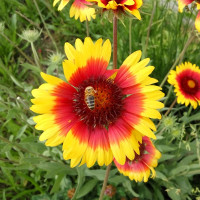Mirabilis jalapa or four-o'clocks or umbrellaworts (mix) / Mirabilis jalapa - a typical species of the genus Mirabilis of the Nyctaginaceae family. Distributed in many tropical regions and is a popular ornamental plant.
A perennial herbaceous plant 30-80 cm tall, grown as an annual in Ukraine. The roots are swollen and tuberous. The stems are erect, densely branched, red, woody in the lower part. The leaves are simple, opposite, elongated-ovate, entire, pubescent, on short petioles.
Thyroid inflorescences contain 3-5 sessile flowers surrounded by a cup-shaped involucre. They open in the afternoon, emit a strong sweetish aroma and thus attract long-proboscis nocturnal pollinating moths of the family Sphingidae (entomophily). The flowers are funnel-shaped, up to 2.5 cm in diameter. The petals grow together to form a funnel-shaped corolla and can be of a variety of colors: white, pink, purple, red and yellow, as well as various transitional colors. There are 5 stamens, a pistil with an upper, unilocular, ovary and a short style. The fruit is a rather large achene, dark brown, with five sharp ribs, containing one seed.
During famine, the leaves of the plant were eaten. The flowers are used to color food. Raspberry dye, obtained from the flowers, is used to tint cakes and jellies.
Medical use of Mirabilis
Parts of the plant have diuretic and wound-healing properties. Potatoes have a laxative effect (hence another Russian name - Mirabilis laxative).
The main active ingredient of the tubers is jalapae resin (Resina Jalapae), obtained (10-20%) by extracting the tuber powder with alcohol. Jalapia resin has a local irritant and, with prolonged use, an inflammatory effect on the mucous membranes. This explains the laxative effect of the jalap root (from irritation of the intestinal mucosa). 05/02/01 is enough to take. It is prescribed against constipation.
The leaves are used to reduce inflammation, and their decoction is used to treat ulcers. The juice of the leaves can be used to heal wounds.
Decorative use of Mirabilis
In cool temperate regions, the above-ground parts of the plant are killed by the first frost, growing the following spring from tubers preserved in the ground. Grows best in full sun.
The plant multiplies very quickly and captivates the entire garden. Some gardeners recommend soaking seeds in a growth stimulant before planting to speed up germination and increase the number of sprouts.

No questions about this product, be the first and ask your question.










